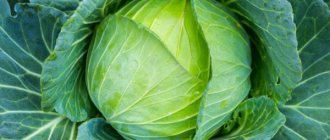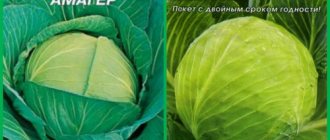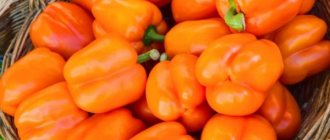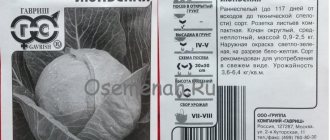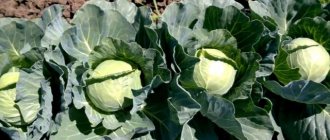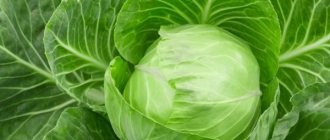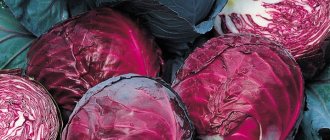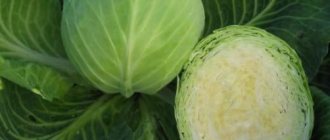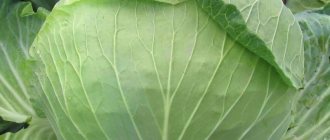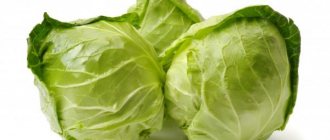Description of Larsia cabbage
Breeders from the American community Seminis Vegetable Seeds, Inc. The cabbage variety Larsia F1 was developed in 2005. It was included in the Russian state register as an industrial and commercial type. Suitable for growing in the middle zone.
Mid-season variety, ripening occurs in 130-140 days from planting. The heads of cabbage are white with a green tint when cut. The leaves have a slight waxy coating of gray-green color. The size of the heads of cabbage reaches from 4 to 6 kg, the maximum weight is 8 kg. The rosettes are wide, the foliage is spreading. Takes root well in open ground.
The leaves of the Larsia variety are gray-green due to a waxy coating.
Larsia cabbage is high-yielding. Taste qualities, according to tasters, 4.4 out of 5 possible points, are characterized as good.
Features of the variety:
| View | White cabbage |
| Kochan | Round shape, dense, short stalk |
| Fetal weight | 4-8 kg |
| Landing | 70x70 cm between sockets |
| Maturation | 125-140 days, mid-season variety |
| Place of growth | Open ground |
| Usage | Universal |
| Diseases | Resistance to fusarium and thrips |
Larsia's heads of cabbage are very dense, all the leaves are adjacent to each other.
Important! The cabbage is juicy and can be stored for 4 months after cutting without visible signs of spoilage.
Features of agricultural technology
Larsia F1 cabbage is grown using seedlings, standard for white cabbage species. When cultivating, several rules are followed:
- germinating seeds are provided with a constant air temperature of 18 - 20 degrees;
- Before moving into the ground, seedlings are provided with 12-15 hour lighting;
- for cabbage, choose beds with neutral soil;
- seedlings are transplanted 30–40 days after seed germination;
- the plant is watered every 6 – 7 days;
- feeding schedule from the day the cabbage is moved to a permanent place: the first - after 2 weeks, the second - after 4 weeks, the third - by 7 weeks.
Sowing seeds for seedlings | Planting seedlings in a greenhouse/greenhouse | Planting seedlings in exhaust gas | Harvesting |
| 3rd decade of March | — | May | September October |
| *dates are indicated for central Russia | |||
Advantages and disadvantages
Larsia cabbage has its advantages and disadvantages. Positive points include:
- high productivity;
- excellent taste;
- versatility in use;
- the vegetable can be cut before its full ripening period for summer salad;
- transportability;
- good presentation;
- short stalk;
- possibility of growing in open ground;
- the heads do not crack;
- there is immunity to fusarium;
- resistance to thrips.
One of the negative aspects is the short storage of the crop - only 4 months. Also, this variety is not intended for growing in a greenhouse.
Attention! Seeds from the first harvest do not convey all the characteristics of cabbage.
The heads of cabbage of the Larsia variety are large, the leaves fit tightly to each other
Pests and diseases
Dangerous pests include the red flea beetle. They fight it with insecticides. The variety is resistant to parasites - thrips insects and caterpillars. Even being in a neighboring bed with infected crops, Larsia is not susceptible to attack by pests.
However, cabbage should not be planted in areas where a diseased crop was harvested. Insect larvae can destroy young shoots of the crop.
Downy mildew on cabbage leaf
Common diseases of the variety include clubroot and downy mildew. Clubroot is a fungal disease whose spores live in the soil. You can fight it by deoxidizing the soil with ash or dolomite flour. The green mass is treated with Bordeaux mixture to destroy the fungus.
Not recommended! There is no need to plant cabbage bushes on soil contaminated with diseases and pests. The field is treated with fungicides and insecticides and left in quarantine for several years. Then you can sow the area with green manure to enrich the soil with nitrogen.
Downy mildew can be recognized by yellow spots on the leaves. To avoid disease, plantings should not be overly moistened; diseased bushes are treated with fungicides.
Yield of cabbage Larsia F1
The amount of harvest from Larsia cabbage is up to 55 tons per 1 hectare of area. This indicator is considered high, so this variety of vegetable is grown for commercial activity. The maximum yield was observed in the Smolensk region - 76 tons of crop from 1 hectare of land. 28,000 plants are planted on 1 hectare of land.
All heads of Larsia cabbage are smooth, large ones tolerate transportation well
Planting and caring for Larsia cabbage
The principle of caring for and planting Larsia is the same as for other types of cabbage. All work begins with the preparation and purchase of seeds.
Seed selection and preparation
Cabbage grains are sold in specialized agricultural equipment stores. Breeders provide quality seeds for sale. It is advisable not to buy them secondhand, as there is a high risk of fraud. They are usually sold ready to plant.
You can carry out the preparation procedure yourself:
- Make a saline solution from 10 g of salt per 1 glass of water. Dip the seeds into it. Some of them will float up, which means they won’t germinate.
- Take out the grains and blot them with gauze.
- Prepare a solution of potassium permanganate, soak the seeds for 1 hour.
- Dry, place in damp gauze and leave in the refrigerator on the bottom shelf for 2 days.
In the meantime, prepare the container and soil. You can make your own soil mixture from the following components:
- 1 part humus;
- 1 part of turf land;
- 1 kg of soil;
- 1 tbsp. l. ash.
Each sprout should have a separate hole to prevent the roots from intertwining
All components are mixed together and calcined in the oven at 180 0C for 20 minutes. Some gardeners use special peat boxes. After being transferred to the soil, they disintegrate and fertilize the plants.
Suitable containers:
- plastic cups;
- cardboard boxes;
- peat boxes;
- small bottles cut in half.
The preparation of seedlings begins at the end of March. After emergence, transfer to open ground is possible after the cabbage has 2 true leaves.
Important! Ready-made soil mixtures do not need to be fertilized additionally. They contain all the necessary components for germination.
Site preparation
Cabbage prefers well-lit, level land. It is advisable to grow vegetables on loamy soils with a slightly acidic or neutral environment. It is forbidden to sow cabbage in places where cruciferous vegetables previously grew; they have the same diseases, which increases the risk of infection.
Preparing the bed:
- At the beginning of spring or late autumn, a plot of land is dug up.
- Remove all stones and roots from plants.
- Fertilizers are added.
The more fertile the soil, the higher the harvest. For cabbage, add the following to the soil:
- humus;
- wood ash;
- nitrophoska solution 10%.
The work is carried out 1 month before planting, so that all fertilizing has time to be absorbed.
Landing
In 10-12 days, seedlings begin to be prepared for transfer to open ground. It is necessary to harden off the plants. To do this, regularly ventilate the room for 3-4 hours. Every day the seedlings are taken out to the balcony in the sun. The first day for 30 minutes, the second for 40 minutes. Gradually increase the time to 1-2 hours a day. This way the sprouts will get used to direct sun.
Algorithm for transfer to the ground:
- Holes 15 cm deep are dug in the garden bed.
- The pattern is 70x70 cm.
- Moisten the hole with warm water.
- They pick up seedlings.
- Close up to the base of the first leaves.
If there is no rain, the seedlings are watered on the same day, and the work is carried out in the morning.
Watering
Good and timely irrigation will contribute to the formation of large heads of cabbage. For the first 14 days, the plants are watered every 4 days, spending 8 liters of water per 1 m2. Further, irrigation is carried out once a week, up to 10 liters per 1 m2.
Important! Increased moisture will cause the roots to die. If it rains outside, the procedure is postponed for a couple of days.
Periodic sprinkling of plantings will help plants survive the heat
Feeding
To get a decent harvest, the plant requires additional nutrition:
- On the 14th day after transfer to the ground, the plantings are fertilized with mullein solution.
- Repeat the same feeding after another 2 weeks.
- 6 weeks after planting, feed with a mixture of mullein and superphosphate.
- At two months of age, a mixture of mullein and superphosphate is added again.
The first fertilizing can be skipped if fertilizers were added to the seed germination boxes.
Loosening and weeding
These are two mandatory procedures. Weeds are removed as they grow. If this is not done, then they will begin to feed on useful minerals from the soil; there will not be enough of them for the cabbage. Loosening the soil helps additional roots form. Both manipulations can be combined.
Hilling is carried out on the 25th day after planting. This will improve the health of the seedlings and help them retain moisture longer in hot weather.
Optimal conditions for growing hybrid Larsia (F1)
In order to get a good harvest, it is necessary to provide the crop with optimal growing conditions. Cabbage is a rather capricious vegetable that requires special attention:
- The vegetable must receive enough light. Do not plant cabbage near trees, fences or other objects that will create shadow. In shaded areas, cabbage tries to stretch out to reach the sun. This is fraught with poor tying of the head of cabbage.
- Important attention should be paid to watering. Unlike other crops, cabbage cannot develop without high-quality watering. The purpose of watering is to keep the soil around the plant moist, preventing it from drying out. If you over-water the vegetable, this can lead to rotting of the stump or cracking of the head of cabbage itself.
- After watering, you need to loosen the soil. Soil compaction, which occurs due to frequent watering of the crop, negatively affects the development of the vegetable, since oxygen begins to flow worse to the root system. For this reason, it is necessary to periodically loosen.
- Cabbage also needs mineral fertilizers.
Application of white cabbage Larsia
The uses of cabbage are varied. White cabbage varieties are used to make preparations for the winter and prepare various dishes and salads. The heads of cabbage are stored for the winter and used until the beginning of the next season.
From the Larsia variety they prepare:
- stewed cabbage;
- vegetable salads;
- cabbage rolls;
- soups;
- canned with other vegetables.
Important! It is advisable to use Larsia cabbage within 4 months after harvest. At 5 months it begins to deteriorate.
It is especially tasty to prepare salads from Larsia for the winter; the cabbage remains crisp even after sterilization
Reviews
Many gardeners give positive characteristics to the hybrid. Examples of reviews:
- “Larsia F1 cabbage has excellent taste. She's not bitter. In the garden, the heads can remain unpicked for a long time and not spoil,” said Kirill from Chelyabinsk.
- “The heads of cabbage are very dense, the leaves are juicy and not hard. Vegetables grow 3–4 kg in size,” shared summer resident Elena.
- “Cabbage is one of the best among similar varieties. Its care is standard, and the fruits of labor are pleasing with their neat shape,” noted Alexander from Voronezh.
Some farmers complain about the short shelf life of heads of cabbage. Many claim that the hybrid does not last 4 months. The heads begin to deteriorate 60 days after harvest.
Cabbage Larsia F1 is a good option for commercial cultivation. The vegetable is easy to cultivate, the yield is high, and culinary experts like its taste.
